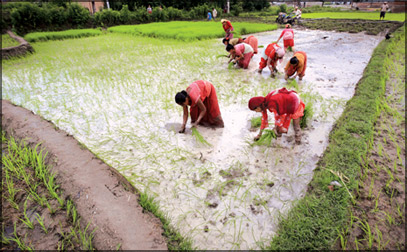Late monsoon brings fears of food shortages in Nepal
Every year, Nepalese rice farmer Ratnakaji Maharjan celebrates the
arrival of the monsoon rains by attending a centuries-old festival in
this historic town near Kathmandu.
The annual event, in which a huge chariot said to carry the Hindu
rain god Machchindra Nath is pulled through the streets of Lalitpur,
draws crowds from across the Kathmandu Valley to celebrate and pray for
a good monsoon.
 |
|
Nepalese farmers plant rice in a paddy
field in Jeetpur village on the outskirts of Kathmandu.
Farmers say the late arrival of the rains will mean crop
failures and food shortages. |
But this year, Maharjan’s mood was more subdued than celebratory as
he queued to worship before the wooden chariot.
“The monsoon is almost a month late,” complained the 35-year-old,
whose family has farmed here for five generations.
“The weather patterns seem to have changed, and we don’t know how to
adjust.”
Nepal’s long-delayed monsoon finally arrived in the Kathmandu Valley
on Monday, allowing local farmers to begin transplanting their seedlings
to the waterlogged rice paddies after weeks of anxious waiting.
But there are fears the delay could prove devastating for this year’s
rice crop, and experts say the increasing unpredictability of the
weather is causing huge problems for farmers in one of the world’s
poorest countries.
“The monsoon this year started around three weeks late,” said Krishna
Prasad Paudyal, senior scientist with the government-funded Nepal
Agriculture Research Council.
“This was a major setback for rice planting, which requires lots of
water. The delayed monsoon meant a lot of young seedlings died, and even
those that could be planted won’t have time to mature enough to yield a
good crop.”
Rice accounts for almost 50 percent of cereal production in Nepal,
which is particularly dependent on rainfall because less than one-third
of its agricultural land is irrigated.
The delay to the monsoon came after the landlocked country suffered
its driest winter for 40 years, resulting in a fall of 20-25 percent in
the production of wheat, Nepal’s second-biggest crop after rice..
— Serious food shortages looming — .
Three years after Nepal’s decade-long civil war came to an end, the
World Food Programme (WFP) says many people are still living in
near-crisis conditions, with 41 percent of the population
undernourished.
Almost one in four Nepalese people live on less than a dollar a day,
and around 2.7 million depend on WFP food aid.
“There are 16 districts that are highly or severely food insecure as
a result of the drought and underlying factors like high food prices and
poverty,” WFP country director for Nepal Richard Ragan told AFP.
“WFP has food-for-work projects in these districts, but we are
rushing to include people living in drought-affected villages not
covered under our activities.”
Ragan said the latest drought was particularly devastating because it
followed more than 18 months of high food prices and years of poor crop
production in many areas.
“Many people have used up all of their food and cash reserves and are
now forced to take drastic measures to survive — like skipping meals and
selling off agricultural assets,” he added.
WORSE TO COME
Some local officials are predicting worse to come if this year’s rice
harvest is poor.
Balgobinda Pathak, a government agriculture official in western
Achham district, said he was expecting serious food shortages later in
the year.
“Last winter, food production was down by 60 per cent decrease due to
erratic weather and some floods,” he said. “This year, 50 per cent of
crops have already been destroyed due to lack of rainfall. We will see a
massive food crisis later this year.”
Experts say Nepal is unprepared for the changing weather patterns,
and will have to do more to adapt to rising temperatures and
increasingly erratic rainfall.
“These kind of erratic weather patterns will have a huge impact on
farming and cultivation.”
AFP
|



